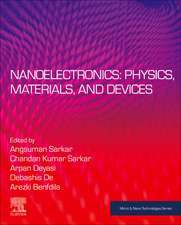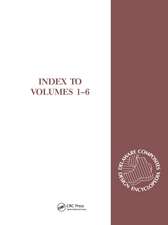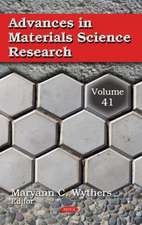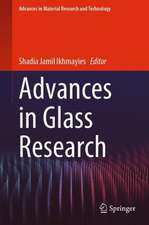Dynamics of Smart Systems and Structures: Concepts and Applications
Editat de Vicente Lopes Junior, Valder Steffen Jr., Marcelo Amorim Savien Limba Engleză Paperback – 30 mai 2018
Written by a team of experts that has been working togetherfor several years in the context of a research network involving internationalinstitutions, this book brings several applications related to smart materialsystems such as vibration and noise control, structural health monitoring,energy harvesting and shape memory alloys. Furthermore, this book also providesbasic knowledge on the fundamentals of smart material systems and structures.Consequently, the present title serves as an important resource for advancedundergraduate and graduate students. In addition, it serves as a guide forengineers and scientists working with smart structures and materials both withan application and basic research perspective.
Smart material systems and structures represent a newparadigm which is increasing the capabilities of engineering systems.Adaptability and versatility are some important aspects related to suchsystems. In brief, research on smart materials is characterized by synergisticallycombining different physical features, such as mechanical, electrical,chemical, and magnetic. As a result, smart material technologies have a hugepotential to enhance the performance of engineering structures openingunlimited opportunities to innovation and economic benefits.
Smart material systems and structures represent a newparadigm which is increasing the capabilities of engineering systems.Adaptability and versatility are some important aspects related to suchsystems. In brief, research on smart materials is characterized by synergisticallycombining different physical features, such as mechanical, electrical,chemical, and magnetic. As a result, smart material technologies have a hugepotential to enhance the performance of engineering structures openingunlimited opportunities to innovation and economic benefits.
| Toate formatele și edițiile | Preț | Express |
|---|---|---|
| Paperback (1) | 699.59 lei 6-8 săpt. | |
| Springer International Publishing – 30 mai 2018 | 699.59 lei 6-8 săpt. | |
| Hardback (1) | 953.20 lei 6-8 săpt. | |
| Springer International Publishing – 14 iun 2016 | 953.20 lei 6-8 săpt. |
Preț: 699.59 lei
Preț vechi: 823.05 lei
-15% Nou
Puncte Express: 1049
Preț estimativ în valută:
133.87€ • 139.49$ • 110.84£
133.87€ • 139.49$ • 110.84£
Carte tipărită la comandă
Livrare economică 03-17 aprilie
Preluare comenzi: 021 569.72.76
Specificații
ISBN-13: 9783319806983
ISBN-10: 331980698X
Ilustrații: VIII, 342 p. 206 illus., 133 illus. in color.
Dimensiuni: 155 x 235 mm
Greutate: 0.49 kg
Ediția:Softcover reprint of the original 1st ed. 2016
Editura: Springer International Publishing
Colecția Springer
Locul publicării:Cham, Switzerland
ISBN-10: 331980698X
Ilustrații: VIII, 342 p. 206 illus., 133 illus. in color.
Dimensiuni: 155 x 235 mm
Greutate: 0.49 kg
Ediția:Softcover reprint of the original 1st ed. 2016
Editura: Springer International Publishing
Colecția Springer
Locul publicării:Cham, Switzerland
Cuprins
Introduction.- ContinuumMechanics.- Wave Motion in Elastic Structures.- Passive and Active StructuralVibration Control.- Nonlinear Dynamics and Chaos.- Introduction to SmartMaterials and Structures.- Piezoelectric Materials.- Shape Memory Alloys.-Electro Magneto-Rheological Materials.— Composite Materials.- PiezoelectricEnergy Harvesting.- Impedance-Based Structural Health Monitoring.- Damage DetectionSystems for Commercial Aviation.
Notă biografică
Prof Dr. Vicente Lopes Junior has more than 25 years of experience in teaching vibration and control in Mechanical Engineering courses. He has been working with smart structures for the last 15 years and has published over 200 technical articles, book chapters, journal and conference papers. He has given numerous short courses in smart structures, control design, and wave motion in elastic structures. He is full professor in the Department of Mechanical Engineering at the São Paulo State University (UNESP), Brazil.
Valder Steffen, Jr is Mechanical Engineer (UNICAMP, Brazil, 1976) and PhD in Mechanical Engineering (University of Franche-Comté, France, 1979). He did his Habilitation at the University of Franche-Comté in 1991. He worked as a visiting scientist at the INSA de Lyon, France, in 1986-87 and was a Fulbright Scholar at Virginia Tech, USA, in 1999-2000. He is the author of over 300 scientific papers published in international journals and proceedings. Hehas supervised 24 MSc students and 18 PhD students. He is now Professor at the School of Mechanical Engineering at the Federal University of Uberlândia, Brazil. He is also member of the National Academy of Engineering. His research interest is focused on dynamics of mechanical systems, optimization and inverse problems, rotordynamics, and smart structures.
Marcelo A. Savi is Ph.D. in Mechanical Engineering and Professor at the Federal University of Rio de Janeiro (Department of Mechanical Engineering, COPPE/Poli) where he develops research and teaching activities. He is the author of several scientific papers published in international journals, proceedings and books summing over 350 publications. He is involved with several research projects sponsored by Brazilian and international agencies, and also industrial partners. He has supervised graduate and undergraduate students, summing more than 100 works. He has administrative experience as head of department, graduate school coordinator, and university committee member. He is member of academic societies including ABCM, where he participates of the Committee of Dynamics; Smart Materials and Structures; and Nonlinear Phenomena and Chaos. His research interests are related to nonlinear mechanics and dynamics, chaos and control; biomechanics and environmental systems.
Valder Steffen, Jr is Mechanical Engineer (UNICAMP, Brazil, 1976) and PhD in Mechanical Engineering (University of Franche-Comté, France, 1979). He did his Habilitation at the University of Franche-Comté in 1991. He worked as a visiting scientist at the INSA de Lyon, France, in 1986-87 and was a Fulbright Scholar at Virginia Tech, USA, in 1999-2000. He is the author of over 300 scientific papers published in international journals and proceedings. Hehas supervised 24 MSc students and 18 PhD students. He is now Professor at the School of Mechanical Engineering at the Federal University of Uberlândia, Brazil. He is also member of the National Academy of Engineering. His research interest is focused on dynamics of mechanical systems, optimization and inverse problems, rotordynamics, and smart structures.
Marcelo A. Savi is Ph.D. in Mechanical Engineering and Professor at the Federal University of Rio de Janeiro (Department of Mechanical Engineering, COPPE/Poli) where he develops research and teaching activities. He is the author of several scientific papers published in international journals, proceedings and books summing over 350 publications. He is involved with several research projects sponsored by Brazilian and international agencies, and also industrial partners. He has supervised graduate and undergraduate students, summing more than 100 works. He has administrative experience as head of department, graduate school coordinator, and university committee member. He is member of academic societies including ABCM, where he participates of the Committee of Dynamics; Smart Materials and Structures; and Nonlinear Phenomena and Chaos. His research interests are related to nonlinear mechanics and dynamics, chaos and control; biomechanics and environmental systems.
Textul de pe ultima copertă
Written by a team of experts that has been working togetherfor several years in the context of a research network involving internationalinstitutions, this book brings several applications related to smart materialsystems such as vibration and noise control, structural health monitoring,energy harvesting and shape memory alloys. Furthermore, this book also providesbasic knowledge on the fundamentals of smart material systems and structures.Consequently, the present title serves as an important resource for advancedundergraduate and graduate students. In addition, it serves as a guide forengineers and scientists working with smart structures and materials both withan application and basic research perspective.
Smart material systems and structures represent a newparadigm which is increasing the capabilities of engineering systems.Adaptability and versatility are some important aspects related to suchsystems. In brief, research on smart materials is characterized by synergisticallycombining different physical features, such as mechanical, electrical,chemical, and magnetic. As a result, smart material technologies have a hugepotential to enhance the performance of engineering structures openingunlimited opportunities to innovation and economic benefits.
Smart material systems and structures represent a newparadigm which is increasing the capabilities of engineering systems.Adaptability and versatility are some important aspects related to suchsystems. In brief, research on smart materials is characterized by synergisticallycombining different physical features, such as mechanical, electrical,chemical, and magnetic. As a result, smart material technologies have a hugepotential to enhance the performance of engineering structures openingunlimited opportunities to innovation and economic benefits.
Caracteristici
Presents fundamentals and main concepts related to the development of smart materials Written by a team of experts working together for several years in the context of a research network involving world-class institutions Serves as an important resource for advanced undergraduate and graduate students Includes supplementary material: sn.pub/extras





























